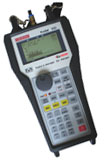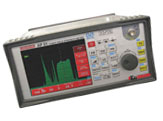Quick Start Guide
 To get the most out of the S22, try to keep the procedure as simple as possible. It is an easy to use instrument, but you have to understand how to get around it! To get the most out of the S22, try to keep the procedure as simple as possible. It is an easy to use instrument, but you have to understand how to get around it!
- Set the instrument is set to IF mode using the LO button (there is IF and 4 different possible LO settings).
- Enter the frequency of what you are looking for, i.e. 1430MHz = 1430 and then RETURN key
- Set the voltake with LNB ON and then LNB POL for 13V or 18V
- Set the attenuation using the ATT button so that you see NOISE in the bottom 1/5 of the display in spectrum mode (in SPEC mode)
- Go to MEA mode to see the signal in signal measurement / acquisition mode.
- Move your dish until you seee some carriers.
- Once you have a signal, his SPEC to toggle between FULL and 200MHz span.
- Move your dish untin you get a carrier at the set frequency (the marker) in 200MHz span.
- If this is a DVB carrier, you may use the instrument's BER function to get a lock and confirm you are on the right carrier.
- Hit BER key then with the QUICK MENU button select "Prmt" and "Symb" to enter the SYMBOL rate i.e.27500.
- If this is the right carrier, you will get a "L" next to the signal level indicating you are LOCKED .
- If this is an AUDIO/VIDEO carrier, you may hit "NIT" and the S22+ will download the NIT.
- Do not user the NIT function on DATA / Internet carriers as it may not yield any results.
- Go back the the main BER screen to peak your dish & cross-pol using the MER value.
Have a look at our step-by-step S22+ tutorial with screenshots.
Other files of interrest for the S22/S22+ spectrum analyzers:
|



 To get the most out of the S22, try to keep the procedure as simple as possible. It is an easy to use instrument, but you have to understand how to get around it!
To get the most out of the S22, try to keep the procedure as simple as possible. It is an easy to use instrument, but you have to understand how to get around it! 